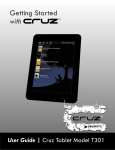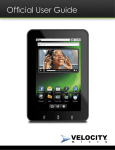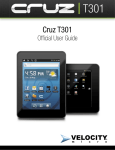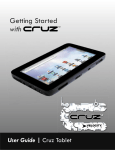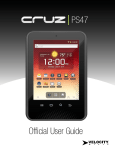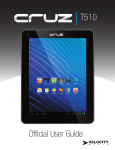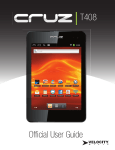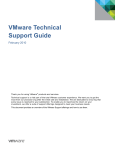Download Velocity CruzReader User guide
Transcript
Getting Started with User Guide | CruzReader and Cruz Reader SE Table of Contents I. Get Acquainted .................................................................................................... 2 II. Resistive Screen ................................................................................................. 3 III. Get Started ........................................................................................................ 4 IV. Your Home Screen .......................................................................................... 5-6 V. Connecting to Wi-Fi ......................................................................................... 7-8 VI. Email Setup ....................................................................................................... 9 VII. Saving Battery ................................................................................................ 10 VII. Device Storage and ASTRO ..................................................................... 11-12 VIII. Transferring Files ..................................................................................... 13-14 IX. File Formats .................................................................................................... 15 X. Preloaded Apps .......................................................................................... 16-17 XI. Buying Books ............................................................................................ 18-19 XII. Installing ePUBS ............................................................................................ 20 XIII. Loading/Playing Media .......................................................................... 21-22 XIV. Installing Apps ....................................................................................... 23-24 XV. Factory Restore ........................................................................................... 25 XVI. Touch Calibration ........................................................................................ 26 XVII. System Requirements ................................................................................27 XVIII. Open Source License .................................................................................28 XIX. Cruz Support .................................................................................................29 XX. Registration and Contact Info .......................................................................30 I. Get Acquainted Figure 1: Device Exterior SD card reader Power on/off Mini USB port Reset Status Bar Volume up/down Touch screen Speakers Headphone jack DC-IN Power Charging LED RETURN TO TABLE OF CONTENTS 2 II. Resistive Screen What does it mean? The Cruz Reader has a “resistive touch screen,” meaning there are two electronic layers inside the screen separated by a narrow gap. When your finger presses on an area of the screen, these two layers are joined, sending the info to the Cruz processor and translating it as input. What makes it work best? Resistive screens work best when using a sharp, precise touch, like that of a fingernail or pen top and do require a little more pressure than the capacitive screens found on many smart phones. Because they do not detect the heat of your finger like capacitive screens, a tool like a stylus can also be used to easily and precisely navigate the Cruz Reader’s touch screen. NOTE: If you choose to use a tool like a stylus, be careful it does not have a metal tip, which could scratch the touch screen! 3 RETURN TO TABLE OF CONTENTS III. Get Started Before continuing, understand that the display has a screen timeout by default set to 15 seconds. If the unit is left inactive for that period of time, the screen will go dark as if turned off. However, it is simply in standby mode. Tap the power button and a screen will appear with an arc with green padlock buttons on either side. This is your Lock Screen. It appears to secure the touch screen from accidental touches. Simply slide one of the locks toward the center of the screen to unlock the device and your Home Screen will reappear. The Battery should have a nominal charge on it out of the box and should charge fairly rapidly. Connect the charger to the DC-IN jack on your Cruz for 20 to 30 minutes for a full charge lasting approximately 10 hours. The charging indicator LED to the right of the DC adapter plug will glow red when charging, green when complete, and off when not needed. Battery life will vary due to many conditions, especially when using Wi-Fi and maximum screen brightness. To start your Cruz, simply press the on/off button located at the top of the device. When you first turn on the Cruz Reader, you will be greeted with a CRUZ logo, then an ANDROID logo, and then your Home screen. Putting your Cruz to sleep To save battery, you should put your Cruz in sleep mode by turning off the LCD display. To do this, simply tap (not hold) the on/off button. Tap again to bring up the lock screen. Powering down your Cruz To turn off your Cruz completely, press and hold the on/off button until the “system options” dialog appears. Then tap “shut down.” RETURN TO TABLE OF CONTENTS 4 IV. Your Home Screen Think of this as your desktop. What goes on the home screen is up to you. You can fill the space with any combination of shortcuts, widgets, and folders you like. Some preinstalled shortcut icons will appear at the bottom, and a Google Search Widget appears at the top. When you power up your Cruz for the first time, you’ll see the main home-screen panel. This panel is typically centered; you can access additional panels on either side of the main one by swiping your finger left or right. At the top of the Home Screen is your Status Bar. At the left, you have a set of four Control Icons. If you are ever in an application that uses full screen mode and therefore hides these icons, simply tap on the center of the screen to make the Status Bar reappear momentarily. From left to right, the icons are Home Search , Back , , and Menu To the right on the Status Bar you will find the date and time. To the left of the date, you will see a Battery Life icon . This icon changes to a Battery Charging icon when the DC Adapter is connected and plugged into the wall socket, regardless if there is a full charge or not. To the left of that will appear a Wi-Fi icon ( ), but only when connected. The icon will show your Wi-Fi signal strength as well. In the center of the Status Bar is the Notification Area. Various icons will appear for different reasons, notifying you of change of status or the completion of tasks being performed. For instance, once a download is started, a download icon will appear. For more information about these notifications, swipe the Status Bar downward to open the Notification Panel. When tasks are completed, you can open these files or clear these notifications. You can close the Notification Panel by swiping up again from the panel’s control handle. The button at the bottom of the screen accesses your App Panel. Tap or swipe the button upward to view and access your installed apps. This is where you look to find your newly installed apps. Tap again or swipe down to close this panel and view your Home Screen again. 5 RETURN TO TABLE OF CONTENTS IV. Your Home Screen (Cont’d) Adding Widgets to Your Home Screen: Widgets are a feature of an application that you may install, allowing you to place a function of that app onto your Home Screen. For instance, you may add an Analog clock to your Home Screen. To add a widget, simply tap and hold (long press) your finger on any open space on your home screen, and select Widgets from the context menu that opens. From there, select any of the available widgets. (The image shown here includes third party apps not included on your Reader. Tapping/holding on an open spot on the homescreen opens this window, from which you choose “Widgets.” After tapping “Widgets,” this window expands and gives you all the widget options that your Cruz has installed or isn’t currently using. If you decide you don’t want the widget on your homescreen anymore, simply tap and hold the unwanted icon or widget. The Application Panel handle becomes a Trash Can. Drag the item to the trash can and release it when it turns red. RETURN TO TABLE OF CONTENTS 6 V. Connecting to Wi-Fi For the sake of this guide, the assumption is that you are connecting to your Cruz to your own home Wi-Fi Access Point (AP) or a free unsecured Wi-Fi hotspot. From the Home Screen, select the shortcut icon that reads Wi-Fi Settings and ensure that both Wi-Fi and Network Notification are enabled with green check marks. After a moment, your Wi-Fi networks list should populate. If you need to rescan for available networks, tap Menu> then tap Scan. The Wi-Fi settings icon is a hammer and a wrench. It should be located in the bottom-right of your screen upon first starting up your Cruz. Detected networks will appear with a SSID to the left (ie, AQFQ7), a status line beneath the SSID, a signal strength icon to the right. Those that are secure will feature a padlock. Secure Those that are open/unsecure have no padlock Unsecure 7 RETURN TO TABLE OF CONTENTS V. Connecting to Wi-Fi (Cont’d) Tap the network you wish to connect to and then click Connect. For unprotected networks, this method should suffice. The Wi-Fi icon ( ) should now appear with full (or near full) strength next to the date and time. Accessibility If a password is required, tap the password text field for the popup keyboard. Many public Wi-Fi hotspots are freely accessible, though not all are. Some are secured, others are open. And still others appear to have no security, but require either access codes or some other form of access agreement acknowledgment via a browser. It is possible to connect to such a signal, appear to be connected, and still require validation. Once the Cruz has successfully connected to any SSID, it is saved. The unit will try to autoconnect to the most recently successful connection. When that SSID is no longer available, it is listed in the Wi-Fi networks list as “Not in range, remembered” in the status line. Troubleshooting 1) If you change the password of your wireless network, be sure to also change the remembered password. 2) If the connection is not made automatically, you may need to scan again by tapping Menu> then Scan. 3) If scanning appears ineffective, turn off Wi-Fi and turn it back on again, then scan again. 4) If your Wi-Fi seems to turn off when your device sleeps, you may disable this under Menu> Wi-Fi Sleep Policy. 5) Be sure that the signal strength is not too weak or not in range, understanding that other radio devices like cordless phones may interfere with the signal quality. 6) Some Wi-Fi signals, though listed as unsecured, may still block connections using MAC address filtering. This will need to be disabled in the Wi-Fi router, or the device’s MAC address will need to be added to the router as an acceptable device connection. 7) Some Wi-Fi signals appear to be unsecured, but once connected, opening the web browser does not take you to your home page, but to a security page where you must enter credentials or agree to terms of use before getting full web access. RETURN TO TABLE OF CONTENTS 8 VI. Email Setup The pre-installed Email app is a simple but effective email client for both POP3 and IMAP email services. Configuration is automatic for some email services. For those that are auto-configured, you only need to enter the email address and password, then click next. Otheriwise, you will need to Prior to beginning, you will need detailed email configuration information which is available from your service provider. You may have to locate the server settings information at your Email Provider’s support website, or you may need to call their support line. Unfortunately Velocity Micro cannot provide assistance with this step. Below is the information you are looking for: Server Type Username or Email Address: Password Incoming mail server Port Outgoing mail server Port Security type You must select POP3, IMAP, or Exchange according to your email service provider’s instructions. Typically this is POP3, but many are now allowing for IMAP service. If you need to connect to an Exchange server, contact your business systems Network Administrator for assistance. This must be either your email alias (the part in front of the @ character), or your full email address. The password is case sensitive This is the address at which your incoming mail is waiting for you. You must specify a port number for communication with your incoming mail server. This is the address which is waiting for your outgoing mail. You must specify a port number for communication with your outgoing mail server. You must specify if/whether a security method is required for communication with your incoming mail server. Next, complete the fields for the Incoming Server portion of the manual setup. After completing the Incoming Server portion of the manual setup, the app will test your settings. If everything is correct, it will proceed with the Outgoing Server portion of the manual setup. Once that test completes as well, you are done except for giving the account a name and entering your display name. 9 RETURN TO TABLE OF CONTENTS VII. Saving Battery Life You may learn about your power consumption in Settings > About phone > Battery > Battery or use an app designed to to analyze usage patterns. Very Low Battery Full Battery Charging Battery Tips on Extending the Life of Your Battery: 1. Understand that streaming audio or video apps will use a lot of battery life 2. Disable Wireless Network Positioning You can turn it off from Settings > Location > Use wireless networks. 3. Switch off Wi-Fi If you’re not close to a strong Wi-Fi signal for extended periods of time, disable Wi-Fi from a homescreen widget or from Settings > Wireless networks > Wi-Fi. 4. Use a Quick Screen Timeout You can alter this option from Settings > Screen & display > Screen timeout. 5. Turn Down the Screen Brightness Reduce brightness to a comfortable level using a widget (Section IV) or at Settings > Sound & display > Brightness. 6. Use Web Widgets Wisely Widgets that access the Web consume more power than widgets that do not. 7. Reduce Automatic Updates Adjust settings within your apps that use an auto-update feature to do so rarely or only manually. 8. You may consider a power management app that will regulate the settings discussed above RETURN TO TABLE OF CONTENTS 10 VIII. Device Storage and ASTRO The device has three areas for storage. There are two SD card slots, one internal micro SD and one external SD/SDHC. There is also an embedded internal storage. Below, you’ll see all of the storage areas broken down and fully explained: Name Internal SD Storage External SD Storage Internal Device Storage (embedded) Capacity Either 2 GB or 4 GB * Up to 32GB 256 MB Appears in ASTRO as Storage Uses /sdcard The Android apps you install will write file folders and app content to this removable storage. You may copy content to this location, but be careful of what you delete as it may impact the function of your apps. /sdcard1 This external slot is for standard and SD and SDHC flash memory cards (up to 32GB) and is useful for storage, or for transferring files to and from your Cruz and your computer. / The Android operating system uses this internal embedded storage. You may not administer these files. * Cruz Reader SE models come standard with a 2 GB SD card, Cruz Reader R101 models include a 4 GB SD card Protecting Your External SD Card To protect your External SD card’s file and directory structure integrity, it should be unmounted before removed. To do this, tap Menu > Settings > SD card & device storage > and under External SD card tap Unmount SD card. This best practice is not always followed by most users, and generally no data loss occurs. When this does happen, the Cruz may attempt to save lost data to a folder called LOST.DIR. This folder generally has useless data and can be ignored. ASTRO is your file manager app. Use it to browse your storage locations and transfer files between the internal micro SD card and the external SD card. It also features an Application Manager to help install or uninstall your apps, and an SD usage monitor as well. Learn more about how to use ASTRO at http://www.metago.net/ 11 RETURN TO TABLE OF CONTENTS VIII. Device Storage and ASTRO(Cont’d) You can also end running applications (End Task) using ASTRO. Follow these steps to place a shortcut on your Home Screen. Open ASTRO > Preferences (Prefs icon on toolbar) > Home Screen Icons > check the box for Processes Now tap Home and tap on your new shortcut to open the app. Stick to the Apps tab and leave the Services and Processes tabs alone to avoid system instability. Common Actions Using ASTRO 1) Copy a File - long click on the file name, select Edit / Copy. - navigate to the new directory and click Edit / Paste. 2) Copy Multiple Files - click the Multi button and select the files. - click Edit / Copy. - navigate to the new directory and click Edit / Paste. 3) Move a File - long click on the file name, select Edit / Move. 4) Move Multiple Files - click the Multi button and select the files. - click Edit / Move. - navigate to the new directory and click Edit / Paste. 5) Install - In the Backed Up Apps tab, check the applications you want to install and click Install Button. 6) Uninstall - In the Installed Apps tab, check the applications you want to uninstall and click Menu / Uninstall. 7) Backup - In the Installed Apps tab, check the applications you want to backup (top check box selects them all). - Click the Backup button. RETURN TO TABLE OF CONTENTS 12 IX. Transferring Files I. Tether via USB to your PC NOTE: While tethered, you cannot use your Cruz to access the internal or external SD cards). 13 STEP 1: Turn on your Reader and connect your supplied mini USB cable to the Cruz device and to your PC (mini USB cable not included with the Cruz Reader SE model) STEP 2: Slide the notification panel down and tap the alert that reads, “USB Connected Select to copy files to/from your computer”, then tap Mount. STEP 3: This should only be required once. After doing this, the alert should change to “Turn off USB storage ... “.This is normal when tethered. STEP 4: Your internal micro SD card will appear within Windows with a new drive letter assigned. If your external SD card is also inserted, it also will appear with its own drive letter. The Autoplay feature of Windows may open asking you what you want to do with the media. Click Open Folders to view files. STEP 5: You may now copy files to and from the device as needed. You may create folders here to organize content, or you may place content in existing folders for use by the application that created the folder. STEP 6: When you are done with file management tasks, You may use the Windows application “Safely Remove Hardware” to unmount the Cruz USB drives. There is no need to tap the alert on the alert panel that reads, “Turn off USB storage - Select to turn off USB storage”. STEP 7: You may now disconnect your USB cable from your Cruz device. Cruz access to the SD cards returns. RETURN TO TABLE OF CONTENTS IX. Transferring Files (Cont’d) II. Transfer via external SD Card STEP 1: Insert external SD card and open ASTRO. STEP 2: Navigate with the up arrow to the root of the device and tap the sdcard1 directory icon to access your card. STEP 3: Select the “Multi” button on the menu bar, then tap each file you want to move to your Cruz device. You know the file is selected when the file name is highlighted. STEP 4: Select the “Copy” button on the menu bar, then tap the Up button on the menu bar to move up one level, then tap the sdcard directory icon to access your internal SD card and select the “Paste” button on the menu bar. NOTE: You may also use email or a 3rd party app that allows for file management via Wi-Fi. RETURN TO TABLE OF CONTENTS 14 X. File Formats The file formats that this device can handle are too numerable to list. The pre-installed apps should allow you to view many Microsoft Office file formats, including Word, Excel, and PowerPoint, as well as many eReader file types, and music and video file types. Most files should work, but not all files are encoded the same. For example, some MPEG4 files will work but others may not, depending on how they were encoded and compressed Natively supported file types include, but are not limited to: ) )) MP3, WAV, AAC, OGG Audio MPEG4, H.263. H.264 Video JPEG, GIF, PNG, BMP Images PDF, TXT, HTML Reader Files DOC, DOCX, XLS, XLSX, PPT, PPTX, PPS Office Documents NOTE: The Android OS handles many file formats automatically, but 3rd party apps may be required to open other files types. 15 RETURN TO TABLE OF CONTENTS XI. Preloaded Apps Each Cruz comes preloaded with many useful applications that can be found by tapping the app panel at the bottom of your home screen. We have compiled below a full list of these preloaded apps, complete with a short description of their purpose/function. Icon Name Requires Wi-Fi Alarm Clock No Allows you to set up to three alarms for easy reminders. ASTRO No This is your file management application. Use it to browse your storage locations, transfer files and even install/uninstall apps. See Section VII for more. Borders ® eBooks Yes Your primary eBook library portal. See section Section XI for details. Browser Yes Default Internet browser. Surf the web, store tons of bookmarks, and stay in the loop! Calculator No Turns your Cruz into a fully functioning calculator with touch screen inputs. Calendar No Stores important scheduled events, organizes your appointments. Stay up to date! CruzMarket Yes Browse, purchase, and install applications specifically selected to work great on the Cruz. Many are free! For more information, see XIV for more. CruzSync Yes After you sign up for a free account, you can store files in hyperspace using this convenient back-up tool. You can stream your MP3 library! Dr.eye Yes Full dictionary application. Requires you to download a database prior to use. eBuddy Yes Instant messenger application. Supports your MSN, Yahoo!, AIM, ICQ, Google Talk and FaceBook contacts in one single buddylist. Email Yes Set up most web based email accounts quickly and easily with this default mail application. Stay in touch through any Wi-Fi hotspot. Purpose RETURN TO TABLE OF CONTENTS 16 XI. Preloaded Apps Icon Name Requires Wi-Fi FaceBook Mobile Yes Log into your FaceBook account and stay connected on the go! No Access photo or video files for play or display right on the Cruz’s full color screen. Use your Cruz as a digital picture frame or fully mobile media hub! Music No Jam to your favorite tunes! Insert headphones or listen through the built-in speakers. This app can play music while other apps are running. Office Suite No Allows you to view Microsoft® Office files, including Excel® Spreadsheets, Word® documents, and even PowerPoint® presentations. Settings No Access device settings for Wi-Fi, sound and display, location and security, applications, storage, search, language and keyboard, and date and time. Twidroyd Yes Tweet updates to all your followers with this useful Twitter application! UerWallpapers No Offers multiple preinstalled wallpaper options that give your Cruz a stylish flair! Upload your own images to make it truly personal! Gallery 17 Purpose RETURN TO TABLE OF CONTENTS XII. Buying Books Your Cruz offers the remarkable opportunity of carrying all your favorite books in the palm of your hand. Each Cruz comes pre-loaded with Borders eBook reader application. This application is a library portal allowing users to sign into their personal account, browse an immense selection of literature, and purchase/download books in an instant! There are over 100 free eBooks available for download. In this section, you will be guided through your first eBook purchase! STEP 1 Click on the Borders eBooks icon located on the Home Screen or on your App panel. The app requires Wi-Fi connection, so make sure you are connected. STEP 2 Once the application loads, create or sign into your Borders account. This is a free service. If you have forgotten your username or password, the Borders website (www.borders.com) is helpful in getting those back. STEP 3 Once you are logged in, you will be presented with a page that shows New Releases, Top Downloads, Free books, and the option to search/browse. Pick one! RETURN TO TABLE OF CONTENTS 18 XII. Buying Books (cont’d) 19 STEP 4 When you find a book you want to download/purchase, click on the book cover. STEP 5 It will bring you to a product page with the book cover, the price, a “Buy Now” button, as well as a ynopsis of the book lower on the page STEP 6 Clicking “Buy Now” will bring up a payment and billing info window. Insert your billing information and click “buy now” at the bottom of the page. The book will be fully downloaded into your library and no longer will require Wi-Fi. RETURN TO TABLE OF CONTENTS XIII. Installing ePUBs Many eReader files are in the ePUB file format. The Cruz Reader does not natively support this file format, so an additional application available on the Cruz Market must first be downloaded. Keep in mind that many ePUB files are also DRM- protected (Digital Rights Management), preventing illegal distribution of publications. In order to read DRM-protected ePUBs, you will need to download a specialized application that manages the DRM requirements. For instructions on how to read a DRM-protected ePUB on your Cruz, visit www.cruzreader.com or call one of our support technicians at 1-800-296-4312 Reading ePUB files that are NOT protected by DRM Step 1 Install FBReader from the Cruz Market > FBReader) onto your Cruz. (Apps > Books & Reference Step 2 Transfer your ePUB files to your internal micro SD card at the following folder location: /sdcard/Books Step 3 Open FBReader and open your Library (Menu > Library). Tap on the author of your choice and then tap the eBook to begin reading. NOTE: It is not yet known what other eReader apps will be made available via the Cruz Market, but this resource is growing. The Kindle app, as well as FBreader, iReader and others work very well. RETURN TO TABLE OF CONTENTS 20 XIV. Loading/Playing Media Not only does your Cruz Reader hold tons of eBooks, browse the web, and keep you connected with social networks, it also functions as a great portable media player too. Just load up your SD card with your music collection, favorite pictures, or digital videos and take all of your favorites on the road with you. Here’s how to get started: Music After loading your music onto your Cruz, simply tap the music icon (found by default on your home screen or by opening the App Panel). You’ll be given the option of selecting by Artist, Song, Album, or custom Playlist. Tap to select. Your selection will begin to play through the Cruz’s built in speakers or through external headphones if attached via the headphone port. The Cruz media player allows you to shuffle, skip, or pause your current selection and even displays the Album artwork when available. Album Artwork Playlists Shuffle Songs Repeat Artist Album Song Title Timeline Playback Controls Pictures You can view, show off, and even edit your digital pictures on the Cruz’s full color, high resolution display. After loading your media (see Section IX) tap Gallery on your home screen or within the App Panel, then select All Pictures. Tap the desired picture to display. To scroll through your collection, tap left or right. You can even set images as your wallpaper or share via your social networks by using the icons along the top of the display. 21 RETURN TO TABLE OF CONTENTS XIV. Loading/Playing Media (Cont’d) Set images as your Home Screen background! Share via social network or email! Delete an image from your memory Video You can play videos stored on your Cruz’s SD card via the gallery function as well. To play, tap Gallery, then All Videos, then select the video you’d like to play. Your selection should begin automatically. Pause or advance your video via the toolbar along the bottom of the screen. NOTE: Your media playback experience will be optimal with no other apps or widgets running in the background. If you experience hesitation or stuttering with your video or audio playback, first try terminating all running applications. See the ASTRO section for help terminating applications. RETURN TO TABLE OF CONTENTS 22 XV. Installing Apps Android Applications are available via the Cruz Market or other third-party sources like the developer’s website. Many Android apps are designed for use with phone devices rather than just tablet devices, but many, many more are great for use on tablets! You can also install any number of eReader Android apps, allowing you to have multiple eReader file formats, all on one Cruz Reader. CruzMarket Visit the CruzMarket for access to 100’s of apps. Some of them are free downloads! To the right you’ll see the expandable App Panel that can be found at the bottom of the homescreen. This is the portal through which all of your applications can be accessed. NOTE: Google does not permit access to the official Android Market at this time. 23 RETURN TO TABLE OF CONTENTS XV. Installing Apps (Cont’d) The installation file for Android has a file extension of .APK. The steps below explain how to install these on your Cruz. Step 1 Download your app to your PC. Files are often distributed in archive format (ie: .ZIP, .RAR). If so, their contents first must be extracted so that the .APK file is all that remains. Note: If the file you download looks like “appname.apk” you can skip to Step 2. Step 2 Unmount the SD card prior to removal. Once unmounted, eject the SD card that accompanied your Cruz device, insert it into the SD slot on your PC, and copy the appname.apk file to it. Step 3 Open the Application Manager (Settings > Applications) and make sure the Unknown Sources option is checked so that you may install 3rd party apps. Step 4 Open your File Manager app and navigate to your /sdcard1 folder to locate your app. Tap to install using Application Manager. NOTE: If your application fails to install, this may be due to an incompat- ibility with your Cruz. Applications that are coded to use hardware features not included in your Cruz (GPS, camera, 3G) may not install or function properly. Uninstalling Apps Slide the app panel up and tap on Settings > then Applications > Manage Applications > tap on the unwanted app> then Uninstall. Follow the prompts to complete the uninstallation. NOTE: Preinstalled apps cannot be uninstalled! RETURN TO TABLE OF CONTENTS 24 XVI. Factory Restore Restoring your Cruz to factory settings will wipe clean all applications, files, and settings from your Cruz’ memory. Proceed only if you understand this. There are two steps to restoration of the Reader, the first is the install and second is the touch screen calibration. Please read these instructions for the install portion of the process. After these steps, see Section XVI on Recalibration to complete the restoration process (pg 25). Step 1 You will need to download the restoration file prior to continuing. Visit Velocity Micro’s Support Hub at www.cruzreader.com or call 1-800-2964312 for help. Step 2 Once you have downloaded the ZIP file, insert a standard SD card into your computer’s media reader. Save the ZIP file to the root of the SD card, not in any folder. DO NOT extract the contents of the ZIP file, leave it as a ZIP archive. Step 3 Remove the SD card from the PC and insert it into the external SD slot of the Cruz Reader. (To be sure that you have sufficient power to complete the update, attach your DC charger and confirm the unit is charging.) Step 4 Hold the power button until the Power Off dialogue appears, then tap Power Off. If the device will not power off, remove back cover, disconnect battery for 5 seconds, then reconnect and replace cover. Step 5 With the Cruz Reader powered off, press and hold the volume up button (keep holding), then press and hold the power button at the same time. Keep holding both buttons, the screen will read CRUZ first, and then the Android robot and software package icons will appear on the screen with a progress bar. Step 6 You may now release the buttons and allow the process to complete. When done, the Cruz load will reappear and the unit should then load normally. NOTE: If you see an Android robot with a triangle with an exclamation mark inside, then the process failed, try again being careful to follow the instructions closely. 25 RETURN TO TABLE OF CONTENTS XVII. Touch Calibration IMPORTANT: It may take a number of attempts to complete calibration. DO NOT give up. If asked to start again, then keep going until you have success. Interrupting the process by powering off the unit can LOCK UP THE TOUCH SCREEN making it impossible to unlock again from the lock screen after restarting the unit. If this occurs, you will need to restore the unit to factory condition. See section XV for help with this process. We do not recommend recalibrating unless you are having a significant issue. Each Cruz’s calibration was already optimized prior to shipment. If you believe you are having a significant issue, begin by laying the Cruz flat on its back and finding a writing implement to use as a stylus. A closed retractable ball-point pen works well. Be as precise as possible, and be careful not to accidentally touch any other part of the screen during the calibration process. STEP 1: Select Home > Menu > Settings > Language & Keyboard > Touch Calibration STEP 2: Follow the instructions in yellow. You will be told to touch at crosses (1), (2), (3), & (4). If not successful, the “Can’t get valid calibration ...” message will be displayed and you will have to begin again at cross (1). STEP 3: If successful, the “Average DIFF = ... “ will be displayed with instruction to touch cross (5). After this, the message changes to “Calibration is finished! Touch any to quit.” HERE’S A TIP! Using a stylus or pen can aid in this process by enhancing the accuracy of your touches. However, make sure the instrument you use does not have a metal point, as this could lead to scratching the touch screen! RETURN TO TABLE OF CONTENTS 26 XVIII. System Requirements Platform 27 Windows Mac Operating System Microsoft® Windows® 2000. Me, XP, Vista, 7 or higher (32-bit or64-bit) MAC OS X v10.4, 10.5 or higher preferred Processor Intel Pentium II or AMD K6-2 300MHz or higher PowerPC G3 300MHz or higher Including Intel-based Macs RAM 128 MB 256 MB Video Super VGA (800 X 600) or higher resolution video adapter and monitor Super VGA (800 X 600) or higher resolution video adapter and monitor USB USB 2.0 USB 2.0 RETURN TO TABLE OF CONTENTS XIX. Open Source License Where such specific license terms entitle you to the source code of such component, that source code is available upon request via vmsupport@velocitymicro at cost from Velocity Micro or visiting our website in http://cruzsupport.velocitymicro. com/ at least three years from the purchase date of this product. If you would like to have a copy of the GPL or certain other open source code in this component on a CD, Velocity Micro will mail to you a CD with such code for $5 plus the cost of shipping, upon request. This product’s software/firmware includes the following open source components: GPL license: 1. 2. 3. Xvid, libmad libfaad2 LGPL license: 1. FFMPEG Full open source agreement is available for download from at http://cruzsupport.velocitymicro.com RETURN TO TABLE OF CONTENTS 28 XX. Cruz Support Cruz Support is available at http://cruzsupport.velocitymicro.com. There are a large number of imformative knowledgebase articles to answer your questions. You can also download the latest manual for your product. Once registered at the site, you can register your product, submit tickets for support, and administer your tickets and personal profile. How Do I Get Support? Registering for support is easy and free. 1. If you have not already done so, create a Support account for yourself at our website: http://cruzsupport.velocitymicro.com/ics/support/mylogin.asp. Note: Those customers who have purchased a Cruz product directly from Velocity Micro may skip this step. 2. Then register your purchased Cruz products: http://cruzsupport.velocitymicro.com/ics/support/productRegister.asp 3. When complete, go to ‘My Products’ (http://cruzsupport.velocitymicro.com/ics/support/myProducts.asp) and submit a ticket for the product you are seeking support for. 4. If you need to return your Cruz product for repair, you must first contact our technical support for a RMA (Returned Merchandise Authorization). Note: Proof of Purchase (http://cruzsupport.velocitymicro.com/ics/support/KBAnswer. asp?questionID=835) is required for RMA services. You create a ticket to upload your Proof of Purchase. 29 RETURN TO TABLE OF CONTENTS XXI. Registration and Contact Info Registration In order to utilize the benefits Velocity Micro’s award winning customer care , you must first register your Cruz soon after purchase. Not only does registering allow us to more accurately provide a premium level of technical support and customer care, it also gives you access to important updates and information throughout the duration of ownership. Registration takes just minutes via the Velocity Micro support hub. We are happy to help with this process should you need assistance. To register your Cruz, please visit: www.cruzreader.com Contact Us Address: 7510 Whitepine Road Richmond, VA 23237 Phone: 800-296-4312 Fax: 804-897-4777 Websites: www.cruzreader.com www.velocitymicro.com Thank you for choosing RETURN TO TABLE OF CONTENTS 30































